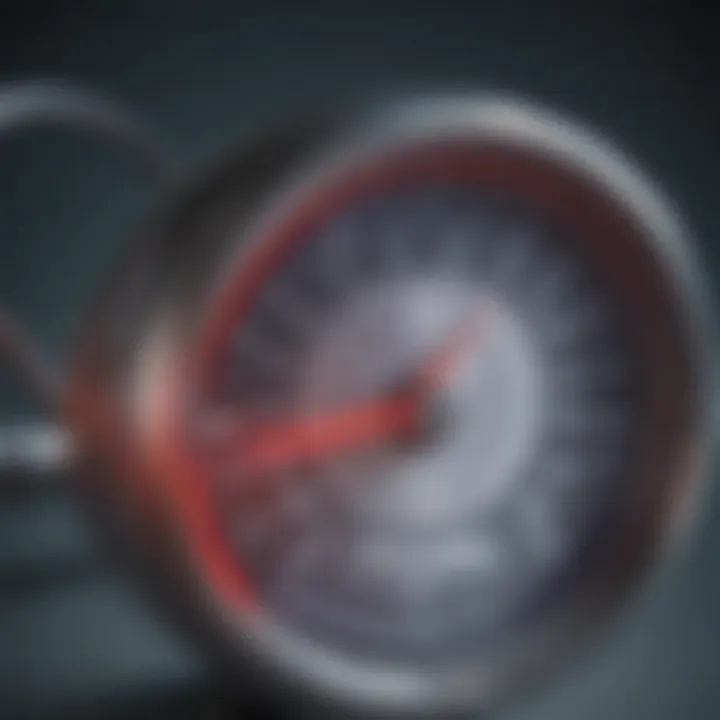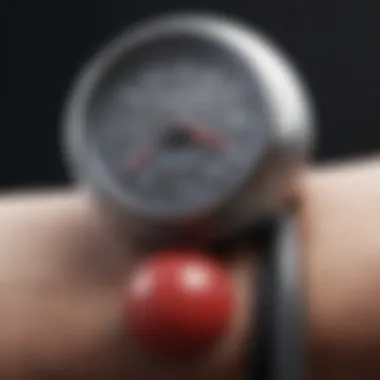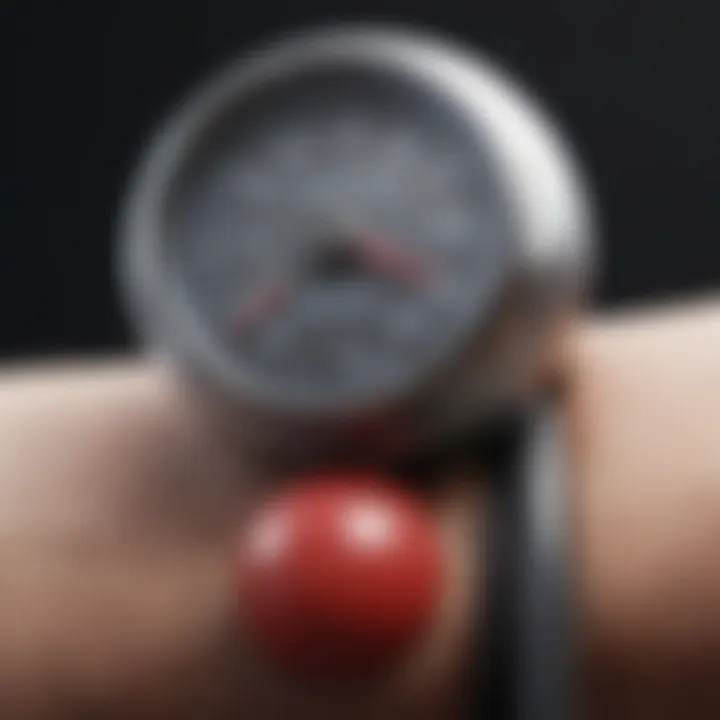Understanding Systolic and Diastolic Blood Pressure


Intro
Blood pressure is often a topic germinating with confusion and misunderstanding. It's a crucial measurement that reflects the force of the blood against the walls of the arteries as the heart pumps. Among the lexicon of cardiovascular health, two terms stand out starkly: systolic and diastolic. These numbers, often scribbled on a medical chart, aren't just random figures; they narrate a story about the heart's efficiency and overall health.
Understanding these terms is essential, as it opens the door to a maze of cardiovascular insights that can be critical for diagnostics and treatment. While many people may casually glance at their blood pressure readings without a second thought, these numbers can be the difference between a clean bill of health and a looming heart predicament.
Overview of Research Topic
Brief Background and Context
Blood pressure consists of two key figures. The systolic pressure, the upper number, indicates how much pressure blood exerts against the artery walls when the heart beats. In contrast, the diastolic pressure, the lower number, shows the pressure when the heart rests between beats. This duality is more than just a numerical representation; it leads to an understanding of heart health that is paramount in today's world.
As years passed, the significance of monitoring these figures has increased. More than just numbers, they assist healthcare professionals in identifying potential health risks such as hypertension, heart attack, and stroke.
Importance in Current Scientific Landscape
In today’s healthcare environment, understanding systolic and diastolic blood pressure has never been more pressing. With cardiovascular diseases remaining at the forefront of global health concerns, knowledge of these measurements serves not only practitioners but also empowers individuals to take charge of their own health. Educating the public on these concepts fosters a culture of proactivity rather than reactivity when it comes to cardiovascular wellness.
"The best way to predict your future is to create it." — Peter Drucker
Observing blood pressure trends over time can also yield insights into broader epidemiological patterns. For instance, certain populations may display increased instances of hypertension, leading to further research on lifestyle, diet, and genetics.
Methodology
Research Design and Approach
Understanding the dynamics of blood pressure involves a multi-faceted research design. Epidemiological studies have frequently employed cross-sectional analyses to correlate blood pressure with various lifestyle factors, such as diet, exercise, and substance usage. Such approaches consider age, gender, socio-economic status, and other critical demographic factors.
Data Collection Techniques
Data collection is pivotal when studying systolic and diastolic blood pressure. Common methods include:
- Clinical examinations: Using manual or automated sphygmomanometers.
- Home monitoring: Encouraging patients to regularly check blood pressure outside of clinical settings.
- Community health surveys: Gathering wide-ranging data from different demographics for comprehensive assessments.
These methodologies not only provide insight into individual health but contribute to a growing database that can highlight trends and patterns across populations.
This article aims to systematically delve into the definitions, significance, measurement techniques, and health risks associated with blood pressure figures. Such knowledge serves as the bedrock for understanding cardiac health on an individual and community level.
Defining Blood Pressure
Blood pressure is often considered the silent accomplice in the intricate dance of human health. Understanding what it is serves as the fundamental stepping stone for grasping its implications on wellbeing. In this section, we will dive into the nuts and bolts of blood pressure, unraveling its mechanics and exploring what these measurements mean for cardiovascular health and beyond.
What is Blood Pressure?
Blood pressure refers to the force exerted by circulating blood on the walls of the body's arteries. It is typically recorded as two numbers: the systolic pressure (the higher number) over the diastolic pressure (the lower number). For example, a reading might be presented as 120/80 mmHg. The systolic number indicates the pressure in the arteries during the contraction of the heart's muscles, while the diastolic number reveals the pressure in the arteries when the heart rests between beats.
This measurement is crucial as it provides insights into how effectively the heart pumps blood and how well the blood vessels cope with the rush. Several factors can influence these values, including age, health status, emotional state, and even the time of day.
The Significance of Measurement
Measuring blood pressure has become an essential aspect of health assessments, as it often serves as a harbinger of overall cardiovascular health. Here's a rundown of why these measurements are significant:
- Indicator of Heart Health: Blood pressure readings can indicate the efficiency of the heart and blood vessels, giving healthcare providers insight into potential issues.
- Screening for Conditions: Elevated blood pressure readings can be the first sign of conditions like hypertension, heart disease, and even stroke, making regular monitoring crucial.
- Personalized Healthcare: Understanding an individual's blood pressure profile allows for tailored health interventions, promoting overall wellness.
"Blood pressure is a lot like the pressure in a balloon; too much and it can burst, too little and it can deflate. Managing this pressure requires balance and awareness."
In summary, defining blood pressure encompasses not just its medical term, but a broader understanding of its role in human health. The path to effective health management starts with acknowledging just how significant these numbers can be in the grand scheme of things, from daily life to long-term health outcomes. This foundational knowledge provides a platform to delve deeper into the specific components of blood pressure, particularly systolic and diastolic values.
Systolic Blood Pressure Explained
Systolic blood pressure serves as a critical indicator of heart health, acting like a window into the state of the cardiovascular system. This measure represents the pressure in the arteries when the heart beats, pushing blood out into the vessels. Understanding the nuances of systolic pressure is essential, not only for those in healthcare but for everyday individuals as well. It can highlight potential cardiovascular issues before they escalate into serious disorders. This section aims to shed light on the physiological basis of systolic pressure, the common methods of gauging it, and the various factors that can influence its readings.
Physiological Basis of Systolic Pressure
Every beat of the heart involves a complex interplay of muscle contractions and artery responses. During systole, when the heart muscle contracts, blood is forcefully ejected into the arteries. This surge creates the systolic pressure, which is typically recorded as the higher number in a blood pressure reading.
The significance of systolic pressure can’t be overstated because it directly correlates to the performance and efficiency of the heart. A healthy reading often resides around 120 mmHg. Elevated levels can signal that the heart works harder than it should, risking the health of arterial walls.
Several types of cells, including endothelial cells in the arteries, respond to changes in blood flow and pressure, showing just how dynamic this system is. Notably, smooth muscle cells manage how much blood flows, either relaxing to allow blood to pass or tightening to restrict it. Therefore, maintaining an optimal systolic pressure is crucial for long-term cardiovascular health.
Common Measurement Techniques
When it comes to measuring blood pressure, accuracy is key. Here are some common techniques:
- Auscultatory Method: Utilizes a stethoscope and sphygmomanometer to listen to blood flow sounds. Typically, this method is used in clinical settings.
- Oscillometric Method: Often found in automated monitors, this method measures fluctuations in cuff pressure and gives a reading based on these changes.
- Ambulatory Blood Pressure Monitoring: This technique involves wearing a portable device that measures blood pressure at regular intervals over 24 hours, giving a more comprehensive picture of one's blood pressure.
Understanding the method of measurement can help patients and healthcare providers discuss blood pressure readings with clarity. Accurate measurements are vital since they can influence diagnosis, treatment plans, and patient education.
Factors Influencing Systolic Pressure


Systolic pressure is not static; various elements can sway its values, which include but are not limited to:
- Physical activity: Exercise can temporarily raise systolic pressure due to the increased heart rate and cardiac output.
- Stress levels: Psychological stress can provoke the release of hormones like adrenaline, raising systolic pressure.
- Diet: High sodium intake and poor dietary choices can lead to elevated systolic pressure. Conversely, diets rich in potassium can help mitigate these effects.
- Obesity: Higher body mass often leads to increased systolic pressure, as the heart must work harder to deliver blood to additional tissue.
- Age: Naturally, as one ages, blood vessels may lose elasticity, impairing their ability to accommodate blood flow, often resulting in higher readings.
Each of these factors exemplifies why maintaining a healthy lifestyle is integral to managing blood pressure. It's a dance of balance and awareness that everyone should consider, especially as they mature.
In summary, systolic blood pressure is more than just a number; it reflects the heart's workload and offers insight into wider health concerns.
Diastolic Blood Pressure Insights
Diastolic blood pressure is an essential component of the overall evaluation of cardiovascular health. It reflects the pressure in the arteries when the heart is at rest between beats, providing insight into how well the heart is functioning in a state of relaxation. Understanding this aspect of blood pressure helps in identifying conditions that could lead to serious health issues such as heart disease or stroke. Within this discussion, we’ll delve into various elements that underscore the significance of diastolic blood pressure, including its physiological role, accurate measurement methods, and various factors that might influence its readings.
Understanding Diastolic Function
Diastolic function is a crucial part of cardiac health. To break it down simply, think of the heart as a well-orchestrated machine, where each part has its role. At the diastolic phase, the heart refills with blood after pumping it out. This phase is vital for ensuring that there is adequate blood volume available for the next beat, directly impacting the body’s overall circulation.
When diastolic pressure is too high or too low, it can indicate underlying issues, such as stiffening of the arterial walls or inefficient heart muscle relaxation. Common symptoms related to diastolic dysfunction can include fatigue and shortness of breath, especially during physical activities. Over time, untreated diastolic dysfunction can lead to more severe complications, highlighting the importance of monitoring this vital statistic.
Measurement Protocols for Diastolic Pressure
Measuring diastolic pressure accurately involves standardized techniques that ensure the readings are reliable. The most common method is through the use of a sphygmomanometer, often found in clinics and hospitals. Here’s how it typically unfolds:
- Preparation: The individual sits quietly for several minutes before measurements, as stress or activity can skew results.
- Placement of the Cuff: The cuff is placed around the upper arm, positioned at heart level.
- Inflation and Deflation: The cuff is inflated to a pressure above the expected systolic pressure, then gradually deflated.
- Detection of Sounds: As the cuff deflates, a healthcare provider listens for Korotkoff sounds with a stethoscope. The disappearance of these sounds indicates systolic pressure, while the point where the sounds disappear indicates diastolic pressure.
These processes, though straightforward, can greatly impact the readings if not performed meticulously. Anomalies in technique or environment at the time of measurement can lead to misdiagnoses, driving home the importance of rigor in these procedures.
Influencing Factors on Diastolic Values
Various factors can influence diastolic blood pressure, making its interpretation nuanced. Some factors to consider include:
- Age: As people age, arteries tend to increase in stiffness, affecting diastolic values.
- Lifestyle Factors: Poor diet, lack of exercise, and excessive alcohol consumption can elevate diastolic pressure. Conversely, nutritious diets rich in potassium and regular physical activity can aid in lowering it.
- Stress and Sleep Quality: Prolonged stress or poor sleep patterns can lead to higher readings, as the body’s stress hormones impact cardiovascular function.
- Medications: Some medications can either raise or lower diastolic pressure, hence requiring careful evaluation when assessing an individual’s blood pressure management.
Understanding these elements not only helps in clinical settings but also encourages individuals to adopt healthier lifestyles to promote optimal blood pressure readings.
Maintaining a finger on the pulse of diastolic pressure can help catch potential health issues before they escalate.
The Relationship Between Systolic and Diastolic Values
Understanding the relationship between systolic and diastolic values is pivotal in grasping how blood pressure reflects and influences cardiovascular health. These two figures, though distinct in their meaning, form a duo that can tell a complex story about an individual's heart function and overall well-being. By examining their interplay, we can glean insights necessary for diagnosing conditions like hypertension, cardiovascular disease, and even certain kidney disorders.
When blood pressure is taken, the results are usually expressed as a ratio, such as 120/80 mmHg. Here, 120 represents systolic pressure, while 80 denotes diastolic pressure. The ratio holds significance, revealing how the heart pumps during contractions and the resistance in the arteries during relaxation. Thus, understanding these numbers helps us piece together the cardiac puzzle, guiding us toward appropriate treatment and lifestyle choices.
Understanding the Blood Pressure Ratio
The blood pressure ratio is no simple equation; it reflects a dynamic dance between the heart and blood vessels. Systolic pressure, the upper number, measures how hard the blood pushes against the artery walls when the heart beats. Conversely, diastolic pressure reveals the pressure in the arteries between heartbeats, when the heart muscles are relaxed.
A key aspect is the pulse pressure, which is derived from the difference between systolic and diastolic values.
Why Does This Matter?
- A wide pulse pressure could indicate health issues, such as arterial stiffness, which often accompanies aging.
- A narrow pulse pressure may point toward insufficient blood flow or even heart failure.
Here are some crucial points regarding this ratio:
- Normal Ranges: The generally accepted normal range for blood pressure is below 120/80 mmHg.
- Systolic-Diastolic Relationship: An increase in systolic pressure, if not accompanied by a proportional increase in diastolic pressure, can suggest isolated systolic hypertension, often seen in older adults.
- Risk Assessment: Understanding the relationship helps in assessing risks; for instance, high systolic pressure with normal diastolic pressure can pose unique cardiovascular risks that merit attention.
Clinical Implications of Systolic vs. Diastolic
Examining systolic and diastolic pressures individually bears clinical implications that cannot be overlooked. The trend in medical practice has shifted towards recognizing that systolic pressure gains more importance, especially in patients over 50. Research indicates that a higher systolic reading is a more significant predictor of cardiovascular events than diastolic pressure in older populations.
However, this should not diminish the role of diastolic pressure. Elevated diastolic levels, particularly in younger adults, can indicate the onset of health problems. Each value provides a unique perspective on the state of a patient's cardiovascular health.
Key clinical insights include:
- Systolic Pressure: Predominantly associated with heart risk in seniors—elevated levels signify greater cardiovascular strain.
- Diastolic Pressure: In younger individuals, it serves as a critical indicator of risk for early-onset hypertension.
- Heart Failure Risk: Understanding the interplay between these pressures assists in predicting heart failure symptoms, tailoring treatment plans accordingly.
Interpreting Blood Pressure Readings
Interpreting blood pressure readings is a cornerstone of cardiovascular diagnostics and management. Understanding these numbers can mean the difference between addressing a potential health issue early and allowing it to evolve into something more serious. Blood pressure readings are typically composed of two measurements: systolic and diastolic pressure. Together, they reflect how well the heart is pumping blood through the body and whether the arteries are responding appropriately.
A clear grasp of what these readings indicate is invaluable for healthcare providers, patients, and anyone interested in their health. This section delves into the normal versus abnormal ranges, the concept of hypertension, and the clinical tools available for interpreting these metrics.
Normal vs. Abnormal Ranges
To appreciate the significance of blood pressure readings, one must first understand the normal ranges and what constitutes abnormality.
- Normal Blood Pressure: Generally, a reading of below 120/80 mmHg is considered healthy. This shows that the heart is functioning efficiently, and the veins and arteries are flexible and strong.
- Elevated Blood Pressure: Readings that range between 120-129 systolic and below 80 diastolic indicate a stage where one might begin to be cautious.
- Hypertension Stage 1: A systolic reading from 130 to 139 or a diastolic reading from 80 to 89 classifies one into hypertension stage 1. This is when we must pay close attention to lifestyle factors.
- Hypertension Stage 2: 140 and above for systolic, or 90 and above for diastolic shows a more concerning level of hypertension which typically requires medical intervention.
- Hypertensive Crisis: This is when the blood pressure exceeds 180 systolic or 120 diastolic, and it's an emergency situation requiring immediate medical attention.
"Blood pressure isn't just a number; it's a glimpse into your cardiovascular health at a moment in time."
Getting these readings correct is crucial. Factors such as time of day, activity level, and even how much caffeine one has consumed can skew these figures. Hence, obtaining multiple readings at varying times ensures accuracy.


Understanding Hypertension
Hypertension, commonly referred to as high blood pressure, is often called the "silent killer" due to its typically asymptomatic nature. It occurs when the force of blood against the artery walls is consistently too high. Chronic hypertension can lead to severe complications, including heart disease, stroke, and kidney failure.
Several causes can contribute to hypertension:
- Genetics: A family history may predispose individuals to high blood pressure.
- Diet: An excessive intake of salt can cause the body to retain water, leading to increased pressure on the arterial walls.
- Lack of Physical Activity: A sedentary lifestyle can contribute to weight gain, which is a risk factor for hypertension.
- Obesity: Being overweight essentially means the heart has to pump harder to circulate blood, which can drive up blood pressure.
It's worth noting that while hypertension mainly affects adults, children can also experience it due to obesity and sedentary lifestyles. Regular monitoring, especially for those in high-risk categories, is crucial for early detection and management.
Clinical Tools for Interpretation
The correct interpretation of blood pressure readings relies on a mix of clinical tools and techniques. Some of the major methods include:
- Sphygmomanometers: These are the traditional devices used to measure blood pressure. They may be manual or digital and are foundational in any medical setting.
- Ambulatory Blood Pressure Monitoring: This technique involves wearing a portable device that takes blood pressure readings at regular intervals over a 24-hour period. It helps in identifying the true pattern of blood pressure changes throughout the day.
- Home Monitoring Devices: Many patients are now encouraged to keep track of their blood pressure from the comfort of their home using automated monitors. These can provide insights into how blood pressure reacts to daily activities and stressors.
- Mobile Health Apps: Modern technology offers various applications that help record and analyze blood pressure readings. These are handy for individuals wanting to monitor their trends over time.
- Wearable Technology: Devices like smartwatches can now track heart rate and, in some cases, estimate blood pressure based on physiological data.
In the end, constantly evolving methodologies and tools significantly enhance our ability to interpret blood pressure readings accurately. It allows for better management of hypertension and shows promise for personalized healthcare decisions, which ultimately can assist in mitigating risks related to cardiovascular diseases.
Health Risks Associated with Systolic and Diastolic Pressure
Understanding the health risks associated with systolic and diastolic blood pressure is crucial for comprehending their long-term impact on cardiovascular health. Elevated levels of either measurement can indicate underlying health issues, serving as red flags for potential complications that can affect not just the heart but the entire body. Addressing these risks is paramount for anyone aiming to maintain optimal health and prevent disease.
High blood pressure, or hypertension, can lead to severe conditions such as heart attacks and strokes. It's easy to overlook, especially since patients might not experience any obvious symptoms; hence, regular monitoring is essential. It's akin to keeping an eye on a smoldering ember that could potentially ignite into a blaze.
Cardiovascular Implications
Systolic and diastolic pressures are more than mere numbers; they reflect the heart's functioning under varying conditions. High systolic blood pressure places strain on the heart, increasing the risk of left ventricular hypertrophy, where the heart muscle thickens in response to elevated pressure. This condition can lead to heart failure, a severe health crisis.
Conversely, elevated diastolic pressure can indicate increased resistance in the arteries. When the heart is resting, high diastolic levels stress the cardiovascular system, raising the likelihood of arterial damage and atherosclerosis. This is important because it shows how both pressures interact and influence overall cardiovascular health. Regular check-ups can mitigate these risks through timely interventions.
Organ Damage and Morbidity
Chronic high blood pressure can stealthily damage organs over time. The kidneys are particularly vulnerable; they filter blood and manage fluid balance within the body. When high blood pressure restricts blood flow to the kidneys, they cannot function correctly, potentially leading to chronic kidney disease. Furthermore, the eyes are not exempt. Hypertensive retinopathy can cause vision loss due to damage to the retina's blood vessels. Research continuously explores how these organ-specific ailments relate back to the overarching theme of blood pressure management.
It's essential to recognize that damage isn’t limited to one organ. According to the American Heart Association, high blood pressure is a major contributor to both heart diseases and strokes. They’ve repeatedly stressed the importance of early intervention and lifestyle modifications to help alleviate these risks.
Age and Gender Considerations
Age and gender are significant factors when discussing blood pressure and its consequences. As people age, blood vessel elasticity tends to diminish, often leading to higher systolic pressures. Post-menopausal women may also witness an increase in blood pressure levels, suggesting that hormonal changes play a role. This highlights the necessity of tailored prevention strategies, as a one-size-fits-all approach clearly doesn’t apply here.
Additionally, studies show that men are generally at a higher risk for hypertension at a younger age compared to women. However, after menopause, the risk for women increases markedly. Understanding these dynamics can aid healthcare professionals in crafting better screening and management protocols for different demographics. By recognizing how age and gender influence blood pressure, one can implement strategies aimed at mitigating these unavoidable risk factors.
Lifestyle Factors Affecting Blood Pressure
Understanding the lifestyle factors affecting blood pressure is crucial as these elements play a significant role in determining cardiovascular health. High blood pressure, or hypertension, can be a silent threat, often lurking without noticeable symptoms until severe complications arise. By recognizing and adapting lifestyle factors, individuals can implement changes that significantly reduce their risk. In this section, we explore key elements that contribute to blood pressure regulation: diet, exercise, and stress management.
Dietary Influences
The saying goes, "You are what you eat," and when it comes to blood pressure, this could not be more true. The foods we consume can heavily influence our systolic and diastolic pressure. A diet that is high in sodium, for example, can lead to fluid retention and a subsequent rise in blood pressure. It’s interesting to note that in some cultures, traditional diets rich in fruits, vegetables, whole grains, and lean proteins, like the Mediterranean diet, show lower hypertension rates. Here are several dietary choices to consider:
- Reduce sodium intake: Aim for less than 2,300 mg of sodium per day, ideally limiting it to 1,500 mg if possible.
- Incorporate potassium-rich foods: Foods like bananas, sweet potatoes, and spinach can help balance sodium levels.
- Opt for whole grains: Choosing whole grains over refined grains can lead to better heart health. Brown rice and whole wheat bread, for instance, pack more nutrients and fiber.
- Limit processed foods: Often loaded with unhealthy additives, preservatives, and high sodium, processed foods should be approached with caution.
Eating a balanced diet not only nourishes the body but also helps maintain healthy blood pressure levels.
Exercise and Its Impact
Exercise isn't just beneficial for body aesthetics; it's a powerhouse when it comes to managing blood pressure. The cardiovascular system thrives on physical activity, which helps keep the heart strong and arteries flexible. Regular exercise can lower systolic and diastolic pressure in many individuals. Here are several ways exercise affects blood pressure:
- Cardiovascular benefits: Aerobic exercises such as walking, running, and swimming strengthen the heart, improving its efficiency in pumping blood.
- Weight management: Maintaining a healthy weight is paramount. Extra pound can add strain to the heart, contributing to rising blood pressure levels.
- Stress relief: Exercise releases endorphins, which can decrease stress and, in turn, lead to lower blood pressure.
Practical recommendations could include aiming for at least 150 minutes of moderate aerobic activity each week, which can seem daunting but can be broken down into short sessions that fit into a busy life.
Stress Management Techniques
Stress is often an unrecognized player in the realm of elevated blood pressure. When faced with stressful situations, the body releases hormones that can cause a temporary spike in blood pressure. Over time, however, chronic stress can lead to sustained high blood pressure. Here are some techniques to manage stress effectively:
- Mindfulness and Meditation: Practicing mindfulness or meditation can help calm the mind and body. Simple deep-breathing exercises can be a great way to start.
- Physical Activity: As discussed earlier, exercise is a dual benefit, contributing to both physical health and stress relief.
- Adequate Sleep: Sleep is often overlooked; however, poor sleep quality can elevate stress levels. Establishing a calming bedtime routine can promote better sleep patterns.
- Social Connections: Building relationships and staying socially active can support mental wellness and reduce feelings of isolation or stress.
In summary, both dietary influences and lifestyle modifications regarding exercise and stress management are pivotal in controlling blood pressure. Making informed decisions can put one on the right path, away from the dangers of hypertension.
Treatment Options for Hypertension
Hypertension, often dubbed the silent killer, can sneak up on individuals, leading to severe health complications if not addressed properly. Understanding the treatment options available for managing hypertension is vital not only for those diagnosed with the condition but also for healthcare professionals looking to provide comprehensive care. This section will delve into both pharmacological and non-pharmacological strategies, illuminating the way forward for effective hypertension management.
Pharmacological Approaches
Pharmacological approaches to treating hypertension differ widely, reflecting the various underlying causes and the individual characteristics of patients. There are multiple classes of antihypertensive medications, each playing a unique role in controlling blood pressure.
- Diuretics: Often the first line of defense, these medications help the body eliminate excess fluid and sodium, thus reducing blood volume. Common options include hydrochlorothiazide and furosemide.
- ACE Inhibitors: Angiotensin-converting enzyme inhibitors, such as lisinopril, help relax blood vessels by blocking the formation of a hormone that narrows them.
- Beta Blockers: These medications, like metoprolol, reduce heart rate and the force of contractions, thereby lowering blood pressure.
- Calcium Channel Blockers: Drugs such as amlodipine relax and widen blood vessels by preventing calcium from entering heart and blood vessel cells.
While these medications can be effective, it's important to note that side effects can arise. Patients may experience changes in potassium levels or kidney function, thus requiring regular monitoring. A medical provider usually tailors the treatment plan to meet individual needs, considering not only the blood pressure measurements but also other factors—like kidney function and the presence of other diseases.


Non-Pharmacological Strategies
Non-pharmacological strategies are equally critical in the fight against hypertension. These methods focus on lifestyle changes that can significantly influence blood pressure levels and often serve as a first step before medication is initiated.
"Sometimes, the best remedy is simply a shift in habits and mindset, as much as it is about medications."
Key non-pharmacological approaches include:
- Diet: Following a heart-healthy diet such as DASH (Dietary Approaches to Stop Hypertension) can help. Rich in fruits, vegetables, and whole grains, this diet emphasizes reducing sodium intake.
- Regular Exercise: Engaging in physical activity for at least 150 minutes a week has been shown to lower blood pressure. Walking, swimming, or cycling can yield significant benefits.
- Weight Management: Maintaining a healthy weight is vital. Even modest weight loss can positively impact blood pressure.
- Stress Reduction: Techniques like mindfulness, meditation, or yoga can reduce stress levels and consequently lower blood pressure.
- Limit Alcohol and Quit Smoking: Reducing alcohol consumption and avoiding tobacco can also play a significant role in managing hypertension.
The Role of Technology in Monitoring Blood Pressure
Monitoring blood pressure has traditionally been a task carried out in clinical settings, relying largely on healthcare professionals and more rudimentary mechanical devices. However, the advent of cutting-edge technology has revolutionized how we track and manage this vital health metric. Today, patients can monitor their blood pressure in the comfort of their own homes, allowing for more consistent and efficient health management. This section will explore some innovative tech developments in blood pressure monitoring and their contributions to healthcare.
Advancements in Blood Pressure Monitors
In recent times, the technology behind blood pressure monitors has progressed significantly.
- Digital Sphygmomanometers: The shift from the standard cuff to enhanced digital devices has made measurements less intimidating. Users can see their readings on a clear display, eliminating the need for a stethoscope, and this ease of use makes it more likely for individuals to check their blood pressure regularly.
- Smart Monitors: Tools like the Omron HeartGuide incorporate smart features, syncing readings with apps and devices. The idea is not just to obtain a number but to understand trends over time, which can lead to better management of heart health.
- Wearable Technology: Gadgets such as smartwatches can measure blood pressure indirectly, often through heart rate variability. While this technology is still being refined, the potential for wearables to continually track this vital sign is monumental in chronic disease prevention.
These advancements lead to more than just convenience; they empower users to take control of their health management, leading to proactive measures rather than reactive ones.
Use of Mobile Apps and Health Trackers
Mobile applications have become invaluable tools in the sphere of health and wellness, particularly for monitoring blood pressure. Here’s how they play a crucial role:
- Data Tracking: Apps like My Blood Pressure Journal enable users to input their readings over time, offering a visual representation of their blood pressure trends. This consistent data tracking allows for personalized insights that can streamline conversations with healthcare providers.
- Alert Systems: Many applications come equipped with settings to set reminders for checking blood pressure, taking medication, or even booking follow-up appointments. Timely alerts can prevent forgetfulness, especially in a busy life.
- Integration with Healthcare Systems: Some applications allow users to share their blood pressure data directly with their doctors. This real-time access to information can lead to better-tailored treatment plans and adjustments as needed.
"Technology, when combined with health monitoring, acts as a bridge bringing patients closer to their caregivers while making health management easier."
- Community Support: This may not directly affect blood pressure measurements, yet platforms like Reddit provide forums where individuals share their experiences with hypertension management. This social aspect can help users feel less isolated in their health journey.
With the rapid growth of technology, not only are monitoring devices becoming more effective, but their ease of use fosters better engagement among individuals concerning their heart health.
In summary, the technological advancements in blood pressure monitoring—ranging from sophisticated devices to user-friendly mobile apps—have made it possible for individuals to gain a deeper understanding of their cardiovascular health. This holistic approach empowers patients and providers to work together towards optimizing health outcomes.
Future Directions in Blood Pressure Research
The exploration of systolic and diastolic blood pressure is not just a static examination of numbers; it’s an ongoing quest for better understanding and innovation. In the face of rising hypertension rates globally, future directions in blood pressure research stand pivotal. As we delve deeper into this section, the importance becomes clear. We aim to address the nuances that can improve clinical outcomes, enhance patient care, and ultimately, save lives.
Innovations in Measurement Techniques
The future of blood pressure measurement is on the brink of significant change. Traditional sphygmomanometers, while effective, come with limitations, particularly concerning accuracy and patient comfort. Innovations are emerging, fueled by technology and research. Here are some pivotal developments that deserve our attention:
- Wearable Technology: Devices like wrist monitors or even smartwatches are now being designed with higher precision sensors. This technology enables continuous monitoring of blood pressure throughout the day, providing a comprehensive view of an individual’s blood pressure trajectory.
- Wireless Monitoring Systems: The advent of Bluetooth-enabled blood pressure cuffs allows for real-time data transport to smartphones. Such systems not only help in tracking readings conveniently, but also make it easier for healthcare providers to analyze trends over time.
- Imaging and Ultrasound Techniques: Sophisticated methods such as Doppler ultrasound are emerging, sidestepping some of the shortcomings of conventional methods. These techniques show promise in gauging arterial stiffness, providing deeper insights into cardiovascular health beyond mere pressure readings.
Thinking forward, the blend of these technologies could lead to smarter healthcare systems that rely on accurate data, paving the way for timely interventions.
Potential for Personalized Hypertension Management
Personalized medicine has emerged as a buzzword across many health disciplines, and hypertension is no exception. The potential for tailoring treatment plans based on individual characteristics can turn the tide in managing blood pressure. Here’s what to consider:
- Genomic Insights: Research into the genetic factors influencing blood pressure is ongoing. Understanding a patient’s genetic predisposition can help in determining the most effective treatment models, leading to better adherence and outcomes.
- Lifestyle Customization: Recognizing that each individual responds differently to lifestyle interventions—dietary changes, exercise regimens, or stress management—is crucial. Future research is likely to refine and personalize these recommendations based on individual responses and preferences.
- Digital Health Tools: Mobile apps that incorporate artificial intelligence can analyze user data to provide customized feedback and reminders to enhance lifestyle modifications.
As the field of hypertension continues to evolve, embracing these personalized approaches will help address the diverse and often complex needs of patients. This represents a shift from a one-size-fits-all method to truly individualized care.
"The revolution in blood pressure research holds the power to transform lives by understanding and treating hypertension at a personal level."
Ultimately, the horizon looks promising. Innovations in how we measure and manage blood pressure may reshape patient care in remarkable ways.
Closure
The conclusion of this article encapsulates the profundity of understanding systolic and diastolic blood pressure in relation to cardiovascular health. This summary does not merely revisit earlier discussions but seeks to crystallize the essential takeaways related to these vital metrics. Blood pressure readings serve as indispensable indicators of heart function, influencing both diagnosis and treatment strategies in clinical settings. Through various discussions surrounding measurement techniques, physiological implications, and lifestyle factors, it's evident that knowledge of systolic and diastolic pressure can empower individuals to take charge of their health.
The examination of blood pressure is not only about identifying whether one falls into a healthy range but also about understanding the myriad factors that contribute to one’s blood pressure status. This encapsulation underlines a critical point: proactive management of blood pressure through lifestyle choices and medical support can significantly reduce health risks associated with hypertension, thus enhancing quality of life.
"An ounce of prevention is worth a pound of cure."
Being proactive about one’s blood pressure encompasses various elements, from regular monitoring, adapting a heart-healthy diet, engaging in consistent physical activity, to effectively managing stress.
Summarizing Key Insights
The key insights outlined throughout the article highlight a multifaceted approach to understanding blood pressure:
- Defining Blood Pressure: Recognizing the definitions and measurements is the stepping stone to comprehending health implications.
- Systolic vs. Diastolic Pressure: Understanding their unique roles aids in deciphering readings and correlating them with health conditions.
- Health Risks: Awareness of the risks associated with abnormal blood pressure values can motivate preventive actions.
- Influencing Factors: Various lifestyle factors play a role in modulating blood pressure, emphasizing the importance of personal responsibility.
- Future Directions: The journey of blood pressure research is ongoing, suggesting that staying informed is paramount.
These insights help individuals not only grasp but also appreciate the significance of managing their blood pressure effectively.
Encouragement for Ongoing Research
Continued research in the field of blood pressure is vital for several reasons. First, the landscape of cardiovascular diseases is ever-evolving. We see changes in risk factors and new discoveries regarding their prevention and management. Ongoing investigations make it possible to enhance our understanding and treatment of hypertension.
Moreover, recent technological advancements, such as improved monitoring devices and digital health solutions, necessitate updated research to ensure their efficacy in real-world applications. By fostering a culture of inquiry and evidence-based practice, the medical community can develop personalized treatment strategies tailored to individual needs.
Finally, encourage active participation in research initiatives and clinical trials. Public engagement can bolster scientific understanding and promote wider acceptance of findings in the community. It’s imperative that this dialogue enriches the collective knowledge around blood pressure management, as informed communities can lead healthier lives.
In summary, the conclusion reaffirms the significance of blood pressure awareness while advocating for ongoing education and research, to address one of the most pressing health challenges of our time.



